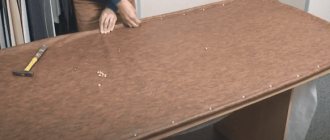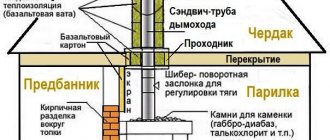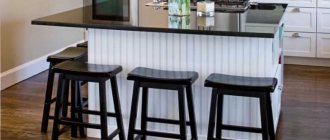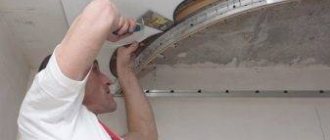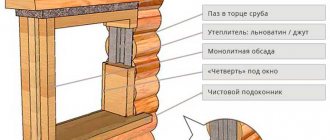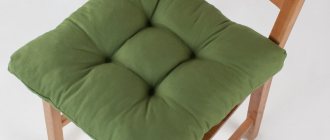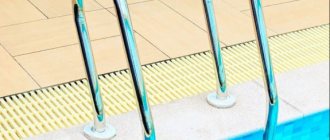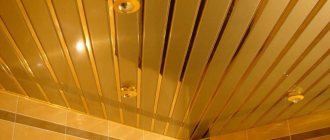Insulation of split doors
This type of canvas has an internal lining that is attached to the frame using self-tapping screws.
There are models in which the interior lining is completely absent. At the initial stage, it is important to choose the right insulation. It is completely wrong to think that polystyrene foam or mineral wool is the best option.
It is much more forward-thinking and more profitable to take polystyrene, which initially has a denser structure.
Next, you need to establish the thickness of the insulation and its area, for which you need to measure the thickness of the fabric, not leaving out the sheathing on both sides. The area is established simply: the height of the door is multiplied by its width. If you are going to insulate a structure that does not have internal lining, an additional sheet of hardboard or fiberboard is purchased, which is then used to cover the insulation itself.
Once all this is in place, you can begin the process itself:
- We remove the inner lining or cut out a new one from hardboard or other material.
- If you are going to personally make the inside of the canvas, you need to carefully check all the dimensions and prepare holes for the handle, locks, peephole and other elements.
- Any metal door has stiffening ribs inside, the space between which is filled with insulation, as densely as possible.
- If you settled on polystyrene, but bought a plate thicker than necessary, hot wire or a long, thin hacksaw will help fix the problem.
- Polystyrene foam or other insulation is not simply squeezed between the ribs, but is also additionally fixed using liquid nails.
- We screw the previously removed casing or install a new one made of fiberboard. In the latter case, it is better to use a magnetized screwdriver or a screwdriver with a magnetized bit, which screws in several screws on each stiffener rib and on all sides of the door leaf. If, due to the design features of the stiffeners, it is impossible to screw fasteners into them, you need to additionally install corners.
- The final stage of insulating the door for the winter will be a thorough grinding of the fiberboard lining, which is done with sandpaper or a fine file.
Alternative insulation technologies
In addition to polystyrene foam, other materials can be used to insulate doors:
We insulate the doors with a rubber lining around the perimeter of the frame
- corrugated cardboard or cellular insulation is one of the cheapest options, but can only be used in mild climates or in apartment buildings with warm staircases;
- felt. Its main advantage is environmental friendliness;
- foamed polyurethane. This material is similar in characteristics to expanded polystyrene, but is softer, has a smaller thickness and is sold in rolls;
- polyurethane foam. It is poured into the space between the inner and outer skin of the door. The excess that has leaked out is removed with a knife;
- vermiculite is a bulk mineral material poured into the interior of the door. Requires good fit of panels to ensure tightness.
The thermal insulation properties of the door can be enhanced by installing sealing rubber pads. They are attached along the inner perimeter of the door frame and should fit snugly against the closed door leaf. This eliminates drafts and conserves heat.
Work execution technology
To carry out the insulation process of a standard metal structure, you will need to proceed in several stages:
- Initially, you need to measure the dimensions of your door along with the profile. Please note that the fiberboard sheet, which is intended for covering the door frame on the inside, must completely hide the profile of the structure. Once the measurements have been taken and the sheet is cut according to the measurements, mark and cut out the holes for the peephole and keyhole;
- Using foam panels cut to size, fill the gap equal to the thickness of the frame profile by fixing them to the metal surface with silicone glue;
- Secure the prepared fiberboard sheet on top using special screws screwed into the metal profile through the fiberboard. Make sure the screws are spaced evenly across the entire surface. Then sand the edges of the sheets using a knife and sandpaper;
- After finishing processing the door leaf, cover it with sealant (foam rubber). To do this, secure the material to the frame, having first removed the protective film from it.
At this point, the insulation work is completed, and you can enjoy the acquired silence and warmth of your apartment, thanks to the insulated iron door.
If you have Chinese doors installed, then over time they will also need to be insulated. Although some people insulate them immediately after purchase. Below we offer you detailed instructions on how to carry out insulation work:
- The first step is to disassemble the door structure. So, on one side you completely remove the fittings and, if any, the upholstery.
- If, when dismantling the facing sheet, it was not possible to maintain its integrity, then it’s not scary. It can be replaced with a sheet of fiberboard. Thanks to this, you will save time during assembly when selecting the intricate configuration of a Chinese bolt or other part.
- Next, install a wooden frame around the perimeter of the door, securing it to the leaf with metal screws. The thickness of the slats can be up to 20 mm, equal to the thickness of the foam.
- Now fill the entire space inside the slatted structure with foam plastic. For this work, it is recommended to use special glue that will not deform the foam. Thanks to gluing, the foam will not hang around inside the door and therefore crumble. The gaps between the insulation are also filled with glue.
- When choosing polystyrene foam, give preference to the material that has a higher density. And given that the price of this insulation is low, it will be possible for everyone to buy it.
- As we have already said, we will cover the door frame with fiberboard sheets. The fiberboard sheet is secured to the metal with self-tapping screws. It is recommended to use clamps for this work. To make it easier to unscrew the screws in the future, it is recommended to first drill a hole in the frame.
- As in foam plastic, so in fiberboard, make appropriate holes for the peephole, door lock and other door elements.
- After preparing the fiberboard and gluing the foam, cover it with foam rubber on top and cover it with the final covering (fibreboard). In this case, the thickness of the foam rubber should be such that the fiberboard sheet can be secured without much effort.
- Finally, cover the surface with leather or other finishing material. For beauty, you can also put foam rubber under the upholstery and, having thought through the shape, hammer in nails with a decorative head.
- Now you can install the fittings and hang the doors on their hinges.
Due to the increase in door thickness after insulation, you may need to replace the door lock or handles. Think about this before carrying out work, otherwise you will have to sleep with the doors open!
Other options for insulating steel doors from Chinese manufacturers
In practice, there are several more options for answering the question of how to warm a Chinese entrance door. This can be done in the following ways:
- Making an outer layer of insulation that is attached to the outside or inside of the sash using glue or self-tapping screws. It is also allowed to cover the heat-insulating material with leatherette, vinyl leather or other leather substitutes;
- Insulation of slopes of the entrance structure and the space between the frame and the opening. This method of performing work is very effective, however, it requires quite a lot of labor;
- Replacement of seals installed around the perimeter of a Chinese steel door. In most cases, manufacturers save on purchasing high-quality rubber profiles. As a result, seals quickly fail. Replacing them does not require serious financial investments and large labor costs.
Do not forget about such options for solving problems with insufficient insulation parameters of a Chinese product, such as installing a second door in the opening or installing a vestibule entrance structure on a common floor area. Both methods are often used in practice, as they combine efficiency and a reasonable level of costs required for the work.
In order to reliably insulate metal entrance doors
the cause of the heat leak must be determined. Most often, it lies in the wear of the rubber seals, and replacing them will be a sufficient measure. In some cases, adjustment of the structure is required and, in more serious cases, its alignment using special equipment.
First, the gaps in the frame and the door frame are eliminated. The presence of cracks can be checked visually or by pressing, the existing play is eliminated. In the places where the box is attached to the walls, the old foam may come off; such places need to be re-foamed or simply plugged. Many people mistakenly believe that glued sealing rubber (the same as on metal-plastic windows) will improve the insulation of metal doors
. Such a seal will only add problems, since the metal structure has no gaps. The perimeter of the vestibule must be covered with foam rubber sealant. It is glued to the frame profile, closer to the inner edge. If the thickness of the foam is greater than the thickness of the gap, one edge is cut off at an angle. When closing the profile, the door leaf should be pressed against the foam rubber only near the very edge on the inside.
Most often, metal door structures are made from a corner or square pipe, which creates cavities inside the door leaf. Insulation of metal doors involves filling this cavity with heat-insulating material. Most often, foam plastic with a thickness equal to the depth of the internal cavity is used for this. The foam is laid in such a way that there are no empty spaces left. It is glued with liquid nails. The resulting gaps are blown out with polyurethane foam, and after drying, proceed to the next stage.
The use of laminated fiberboard will allow better insulation of metal entrance doors, as it will cover the unaesthetic appearance of foam plastic. It is more convenient to fasten fiberboard with metal screws, having previously drilled holes. Fiberboard sheets are fixed in the desired position using clamps, holes are drilled through the sheet and screws are screwed in. It is recommended to fasten from top to bottom; as you fasten, the sheet will gradually level out.
Recently, people have increasingly become interested in how to insulate a Chinese door
, stamped from thin tin and having a lattice paper filling inside. Chinese structures have all the joints with the door block fitted quite well; the paper filling makes them warmer than ordinary hollow ones, but they will have to be insulated. Thermal insulating material made of foamed polyethylene (10mm) is glued to the inside; you need to choose a material with a smooth and dense soft surface. After insulating a Chinese door with such material, it can be spray painted with brown (or any color) paint. The result is an original door leaf with imitation leather.
Door with split frame
When insulating a hollow iron Chinese door, you need to pay attention to the choice of insulating material, since the heat and sound insulation of the room will largely depend on its quality
Material selection
Firstly, it is better to prefer polystyrene foam to polystyrene foam, since it has a denser structure, which means it will last longer.
Secondly, you need to purchase insulation of the required thickness and area. To determine the thickness, you should measure the width of the door at the end, taking into account the trim on both sides. We find out the area by measuring the door horizontally and vertically.
So, all the materials are prepared - you can get to work.
Removing the trim
We remove the inner door trim or prepare a new one from fiberboard or hardboard. If the area of the fiberboard sheet is larger than the area of the door leaf, we mark and cut out a part of the required dimensions. Next, we determine the location of the peephole, door handle, protruding parts of the lock and cut out grooves or drill and bore holes with a file. Do not neglect to “try” the fiberboard sheet onto the door leaf to ensure that all sizes match.
Inside, Chinese doors have metal stiffening ribs that divide the perimeter of the door leaf into cells. These are the ones that have to be filled with insulation.
Installation of insulation
Expanded polystyrene is cut into pieces according to the size of each of the cells between the stiffeners. If you were unable to buy a slab of the required thickness, you can reduce it to a suitable size with a hacksaw or hot wire stretched between two wooden handles. Expanded polystyrene is attached to “liquid nails” and lightly pressed against the metal.
Frame installation and sheathing
When all the cells between the stiffeners are filled with polystyrene foam, we proceed to attach the removed trim or prepared fiberboard sheet to the door frame.
It is more convenient to use a screwdriver with a magnetized bit or a magnetized screwdriver. In the case of fiberboard, you can also drill holes in the metal frame and the sheet itself. We screw in 3-4 screws on each side of the door leaf and on each stiffener rib. If the design of the ribs is such that it is impossible to screw self-tapping screws into them, first attach a corner to each rib.
The final stage is grinding the fiberboard sheet exactly to the edge of the door using a file or sandpaper.
Alternative methods
Installation, as a rule, is carried out along the entire perimeter and is fixed with leatherette strips. After installation, be sure to check the entire area for gaps, joints, cracks or holes. They shouldn't exist. You can eliminate them using improvised means (foam rubber or leatherette).
What to do with one-piece fabric
It would be very convenient if doors from Chinese manufacturers initially had a layer of insulation. But since this option helps us save money, we prefer to fix the shortcomings ourselves.
All work takes place in several stages:
- the entire internal part is completely eliminated;
- another frame is pre-created;
- Self-tapping screws are screwed into the wood and secured with a layer of putty. After which they are painted or varnished.
- Now you can start direct insulation. All material is fixed with glue.
- all this is covered with a sheet of chipboard, which must be measured and cut in advance;
- All that remains is to apply a layer of foam rubber and cover it with leatherette.
Keep in mind that after sealing, the dimensions of the door will become much larger, so you need to prepare the appropriate fittings in advance.
What to do with one-piece fabric
Of course, it would be nice if the Chinese-made iron door was initially insulated. Since this makes the final product more expensive, it is customary for us to take an economical option and improve it to the best of our abilities. In the case where the entrance door structure has one-piece panels, you need to be prepared to change the internal appearance of the door leaf and make a new overlay. But first things first:
The door completely gets rid of the fittings located on the inside. An additional frame is made, as in the photo. To do this, wooden strips are fixed along the entire internal contour of the canvas with metal screws, the width of which should be similar to the width of the insulation. It will be better if the holes for the screws are prepared in advance in the metal base, and their diameter will be slightly smaller than the circumference of the fasteners themselves. At this stage, it is recommended to secure several cross slats, and all wooden elements should be pulled as tightly as possible to the metal base. Self-tapping screws must be screwed into the wood with a recess, the fixation points must be sealed with wood putty, after which all wooden parts must be painted or varnished. Then the Chinese door is filled with the selected insulation, which it is advisable not only to press well and squeeze into the newly created frame, but also to fix it with “Dragon” type glue. All this is covered with a sheet of fiberboard of the required dimensions, which, again, is attached with self-tapping screws or even nails to wooden planks. Foam rubber is placed on top, onto which high-quality leatherette is stretched. The latter is attached with specific nails with decorative or hidden caps
The entire process can be followed in more detail via video. Since after such insulation of the door leaf it becomes much wider, it is important to buy the appropriate fittings.
Alternative methods
If you decide to protect a private home with a Chinese door, try to make sure that all its seams are tight. Then it will be possible to insulate the structure by filling the internal cavities with vermiculite or perlite. And one more thing: do not rush to get rid of the ancient entrance panel. Try living with two doors with an air cushion between them. It has excellent sound and heat insulating abilities, and is quite capable of replacing self-made insulation with hundredths and preserving the metal sheet from freezing.
Chinese entrance doors delight owners with their reasonable price and appearance. However, they do not always provide the required level of noise and heat insulation. It is quite possible to correct this deficiency with your own hands and without serious costs.
Doors made in China are characterized by savings on materials. This greatly reduces their price tag in the store, but gives rise to a number of problems:
- insufficient thermal insulation. It can manifest itself in the form of cold drafts from the corridor and the appearance of condensation on the inside of the door. The main reason is that the insulation is too thin and/or unevenly laid. In some cases it may be absent altogether;
- poor sound insulation. The main material that helps absorb external noise is insulation. If the manufacturer saved on it, then there can be no sound insulation.
You can get rid of both disadvantages by installing insulating material inside the door frame yourself.
One-piece door
How to insulate a hollow iron entrance door with one-piece panels? Be prepared for the fact that the appearance of the front door from the inside will change. Of course, the best option is to order a door with insulation already installed inside, but if your financial capabilities are limited, you can carry out the insulation yourself.
The general scheme for insulating one-piece Chinese doors looks like this:
- the fittings on the inside of the door are dismantled;
- an additional frame is created. To do this, along the perimeter of the door, wooden slats are secured with metal screws, the thickness corresponding to the selected foam plastic. The optimal width of the slats is 25-30 mm, thickness is 20 mm;
- screws are screwed into pre-prepared holes in the metal frame, and the diameter of these holes should be slightly smaller than the diameter of the screws;
- Additionally, several horizontal intermediate slats can be fixed at the same distance from each other;
- important: the slats must fit tightly to the metal. If you find gaps, screw in screws in this area;
- the screws must be screwed in so that they go somewhat deeper into the slats;
- the fastening points are sanded, the recesses are filled with wood putty and covered with paint or varnish;
- all areas between the slats are filled with foam plastic, which is attached with “Dragon” glue;
- a pre-prepared fiberboard sheet is applied to the foam plastic - fastening to the slats is carried out using nails or self-tapping screws;
- The fiberboard is covered with foam rubber;
- the last layer is leatherette, which is stretched and nailed around the perimeter with special nails;
- fittings are being installed. In this case, you need to make sure in advance that the new fittings (door handle, lock secret, peephole) have suitable dimensions, since after insulation the entrance iron door will become wider;
- the voids between the wall and the door frame are thoroughly cleaned and then filled with polyurethane foam. After it dries, the protruding areas are removed with a sharp knife;
- The foam layer is covered with putty, liquid cement mortar or plaster.
Filling with liquid insulation
There is also a method for insulating hollow metal doors, such as filling the internal space with foamed perlite or vermiculite. It should be noted that this method will only be effective if the welding seams are sealed. Otherwise, the filler will simply spill out through the cracks.
In addition, there is no guarantee that you will completely fill the space with insulation - even if you use an air compressor.
A simple way to insulate your front door with your own hands
Doors from well-known brands are usually well insulated inside and out. But if you bought an inexpensive Chinese door, you will have to insulate it yourself. In the best case, it can be disassembled into components using a screwdriver, but you may have to cut off the inside with a cutter or metal scissors. Then it will need to be carefully welded back or replaced with plastic with a beautiful pattern.
Work order:
- Remove the door from its hinges;
- Unscrew handles and door locks;
- We disassemble the door frame;
- We lay the selected insulation or blow it with foam;
- Assembling the door frame;
- We screw on the handles and locks and put the door in place.
Insulation of Chinese metal doors with liquid filler
There is another method for insulating Chinese doors. This is the use of perlite or vermiculite.
Perlite is a recycled paper material. It has good thermal insulation properties, does not react with any substances and does not burn. This is a light, crumbly material, when working with which it is necessary to avoid drafts.
Perlite insulation
When using this material, it is necessary that the welding seams are sealed.
Filling the door space with perlite is done using an air compressor, but even in this case there is no guarantee that the voids will be completely filled. Therefore, it is more effective to use the open method to insulate doors.
We insulate the front door in a private house
In the private sector, it is necessary to insulate the front door especially carefully, since it is not protected from rain, snow, wind, and frost. A wooden door can dry out and crack, and a steel door will be covered with frost from the inside in cold weather. Therefore, comprehensive insulation is recommended.
If you need to insulate the front door in a private house, then special attention should be paid to the insulation of both the door and the frame itself
How to properly insulate doors in a private house:
- The seal is glued both to the door itself and to the door frame.
- The inside of the metal door must be foamed or filled with mineral wool (foam plastic). If laid correctly, there should be no gaps in the material, otherwise cold will penetrate through them.
- The outside of an iron door does not need to be upholstered with anything, but it is recommended to protect a wooden door from moisture with waterproof material. The cracks and cracks are first covered with a special mastic.
- Insulation material is also placed on the living room side. It can be leatherette with a backing, felt, an old cotton or wool blanket.
Insulation of Chinese metal doors with liquid filler
Craftsmen often use liquid fillers to insulate a door with their own hands. But to ensure that the material does not crumble, it can only be used if the seams are sealed. Care must be taken as there is no guarantee that you will be able to completely fill the space. And this is one of the most important points.
Required materials and tools
In order to efficiently insulate a metal door at home, we need:
- insulation material;
- drill;
- liquid Nails;
- foam for installation.
These are the most basic tools without which you cannot get started.
How to insulate a door in an apartment quickly and efficiently
In apartments, doors are not exposed to atmospheric conditions and sudden temperature fluctuations, so the main problem is the draft wind that blows through the cracks. One method of eliminating drafts is to install tightly fitted double doors. You can use a more economical method and simply stick a silicone foam or rubber seal around the perimeter. The material is sold in construction and hardware stores.
To insulate the entrance door to an apartment, you can use a foam rubber seal.
Sequencing:
- First you need to measure the gap between the door and the frame in order to buy insulation of the required thickness;
- Then the seal is glued around the perimeter or pressed into a special groove.
The outside doors of apartments are upholstered with vinyl leatherette, leatherette or natural leather, having previously been insulated with foam rubber or batting. Stepping back about 5 millimeters from the edge of the door leaf, the material is nailed down. This must be done with special nails with a wide head or a construction stapler. The sides can be decorated with a wide strip of leather or leatherette. The inside of doors in apartments is usually not insulated.
Material selection
There are several types of insulation to insulate a Chinese door. Most often used:
- Liquid. These include polystyrene foam and penoplex. They are easy to install and have an affordable price. This is the best option for a country house or cottage.
- Soft. These include glass wool and mineral wool. This is an environmentally friendly and fire-resistant material. Designed for entrance doors in apartments and small spaces.
- Inflatable. For example, polyurethane foam. The main difference is the high cost and decent quality.
It is also worth considering additional materials and tools for insulation.
Insulation of entrance structure from China with non-removable fabric
It is somewhat more difficult to insulate a cheap Chinese door if it does not have a collapsible leaf design.
In this case, two options apply. The first of them is simpler and faster, but less effective. It involves making holes in the upper part of the canvas, through which some kind of bulk filler is poured into the internal cavity. In this role, vermiculite or polystyrene foam in granules can be used, as well as crushed mineral wool or other thermal insulation materials with similar characteristics. The second option involves insulating the Chinese entrance door by performing the following steps:
- the sash is removed from its hinges;
- after this, using an angle grinder, carefully cut off the tacks that connect the inner sheet of metal to the frame of the steel door;
- the layer of glue located between the metal sheets and also holding them together is cut off with a knife;
- the inner steel sheet is dismantled or carefully bent, after which the filler is replaced with a more effective one;
- if the owner wishes, an additional layer of heat-insulating material can also be installed in the form of the above-mentioned foil-foamed polyethylene foam;
- upon completion of the above work, the inner sheet of metal is installed in place and attached with glue or, which is noticeably more reliable and durable, by welding using a semi-automatic machine and wire, the diameter of which is selected based on the thickness of the steel.
It is important to note that often the steel sheet is not reinstalled. Instead, the insulation is sheathed with some decorative material or ordinary plywood
This allows the use of a thicker layer of filler than that which was provided during the manufacture of the entrance structure. At the same time, this option for performing the work will require replacing part of the fittings, as it will lead to a change in such product parameters as the thickness of the sash.
Insulation of the door leaf
Cheap Chinese doors are usually made without internal insulation, so the owners have to modify the design themselves.
The better to insulate
Before insulating the entrance metal door of an apartment, you need to decide on the type of filler in the interior space of the door leaf. Depending on the internal structure of the door, use:
- polystyrene foam boards or polystyrene foam;
- bulk materials (sawdust, expanded clay);
- polyurethane foam;
- thermal insulating mineral boards.
Polyurethane foam is considered more reliable and durable, but due to its high cost it is not used often; polystyrene foam and mineral wool insulation are much more popular.
Insulation with mineral wool slabs.
Materials and tools
Before insulating an iron door from the inside, you will need to purchase material and prepare the necessary tools:
- material selected as insulation;
- polyethylene film;
- wooden blocks with a cross-section corresponding to the thickness of the internal space of the door leaf;
- self-tapping screws;
- metal reinforcements for wooden frames (corners, profile);
- electric drill;
- construction knife;
- liquid Nails;
- hacksaw;
- Screwdriver Set.
Before insulating the iron entrance door from the outside, you will additionally have to purchase:
- dermantin or eco-leather;
- felt material.
Insulation instructions
Work on insulating the inner and outer parts of the canvas is different. Most often, internal insulation of the door is carried out, because... in this case it has to be disassembled.
Inside
To place insulation inside a metal door you will need to perform the following steps:
- the door is removed from its hinges and installed on a hill;
- dismantle handles, locks and latches;
- dismantle the fiberboard sheet from the inside of the door;
- take measurements of the internal space to prepare the wooden frame;
- individual elements for the frame are cut from the block;
- an adhesive composition is applied inside the door leaf and a plastic film is laid;
- assemble the frame (when assembling, you should take into account the locations of the locks and through handles);
Installation of a wooden frame. Foaming the gaps between the frame and the door.
- to enhance the rigidity of the frame, corner joints are reinforced with iron corners;
- Insulation is placed inside the frame cells;
- glue is applied to the sheathing, after which the top is covered with plastic film;
- small cracks and gaps not filled with insulation are filled with polyurethane foam;
Filling the seams between the insulation and the frame.
- the inner fiberboard sheet is returned to its place and secured with self-tapping screws;
- the door is hung on hinges and handles, locks and latches are inserted.
Outside
If it is necessary to sheathe the outside of a steel door with eco-leather, perform the following work:
- The door is removed from its hinges and placed on a hill.
- The felt insulation is cut to size and glued to the door leaf using glue (a 20 mm indentation is made along the perimeter of the door leaf).
- Eco-leather or dermantine canvas is cut to exceed the dimensions of the canvas by 50 mm.
- Dermantin is glued with a bend to the inside of the door leaf, and it is necessary to maintain uniform tension on the material.
- A metal strip is stretched around the perimeter of the door leaf, securing it with self-tapping screws. The tape serves as an additional fastener for the sheathing.
To obtain a decorative surface, you can additionally secure the material to the surface of the door using special self-tapping screws with curly heads.
Materials needed for work
The role of the basis of the door structure is played by a metal frame made of some profile material, sheathed on the outside with an iron sheet. This kind of door can guarantee protection against burglary, but it will not be able to protect your home from cold air currents and extraneous sounds.
To insulate an iron door, you should opt for foam panels, the thickness of which is equal to the width of the frame profile. In addition to the panels themselves, you need to purchase additional materials:
- sealing foam on a self-adhesive basis;
- sandpaper;
- adhesive tape;
- wood fiber boards;
- sealant.
You will also need the following tools to get the job done:
- jigsaw;
- electric drill;
- screwdrivers;
- sharpened cutter;
- pencil, ruler, measuring tape.
Door design options
The most common two options for installing entrance doors are detachable (collapsible) and permanent (non-removable). One-piece doors have the following features:
- The basis of the frame can be not only a metal profile, but also a simple metal strip or corner;
- there may be no internal stiffeners;
- the casing is made of thin metal and welded to the frame.
Detachable structures involve fastening the casing not with welding, but with self-tapping screws. This slightly increases the cost of the door, but greatly improves its maintainability and simplifies modernization. In addition, to facilitate the installation of panels, most manufacturers use a metal profile, which has a beneficial effect on the mechanical strength of the structure. Detachable structures often have internal lining made of decorative materials.
In addition to the frame, insulation and cladding, Chinese metal entrance doors are supplied with the following elements:
- door frame. Most often made of metal. In cheap options, it may not be included in the price, but must be purchased separately;
- lock and handle. Can be combined or installed separately; Some lock models are equipped with vertical locking bolts, which increases the vandal resistance of the structure
- peephole
To increase mechanical strength, the doors are equipped with stiffeners made of metal corners. They are located in the inner part of the frame.
Recommendations: how to insulate a Chinese iron entrance door (video)
Metal entrance doors, made by the hands of hardworking Chinese, are firmly located in the living areas and houses of our compatriots. And it doesn’t delight, because their price, relatively high quality of workmanship and diversity of appearance regularly attracts and calls people. It’s a shame, similar structures have one significant drawback - the lack of a good layer of thermal insulation, which is unacceptable in our climate conditions.
We insulate a Chinese door
As usual, home craftsmen quickly figured out the situation and found ways to insulate
Chinese wooden panel to preserve the expensive heat of the house. It turns out that if you have a very small set of devices and skills in handling them, it is quite possible to make a real wall out of a budget door, through which not a single draft will pass. Sounds tempting, don't you agree?
This publication offers options on how you can insulate
detachable and one-piece entrance panels from China.

